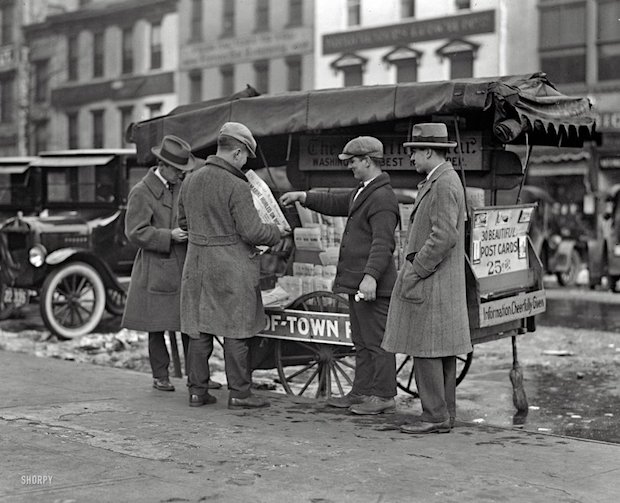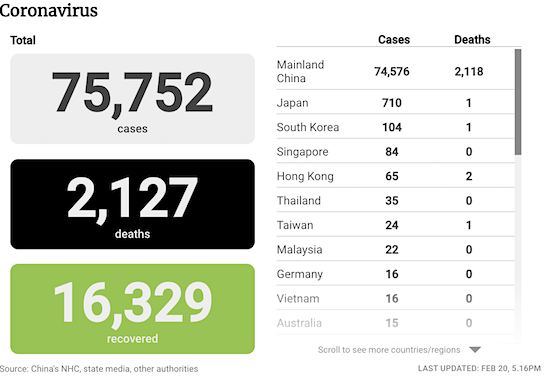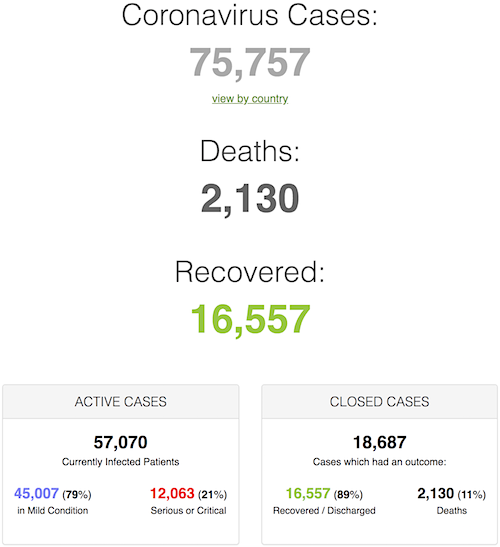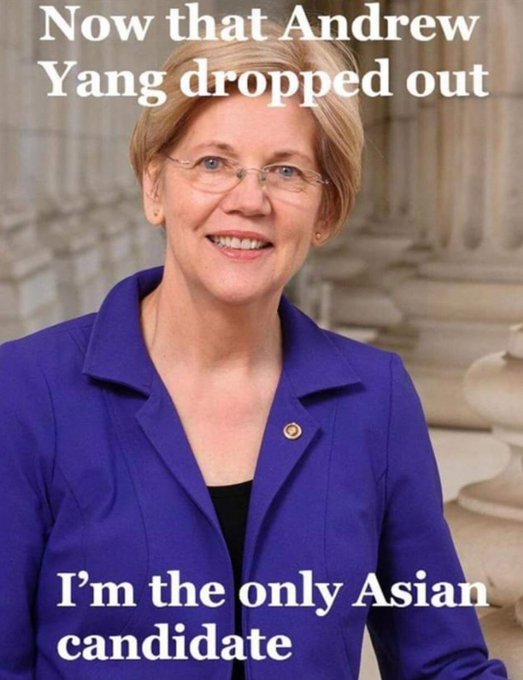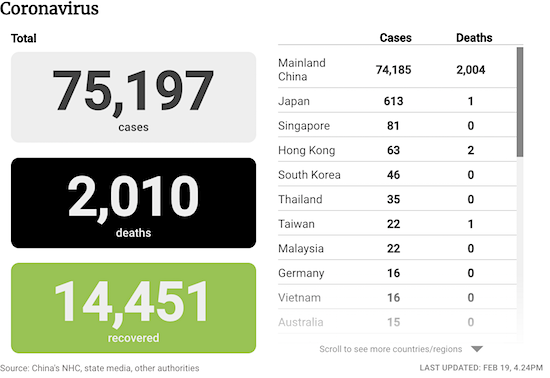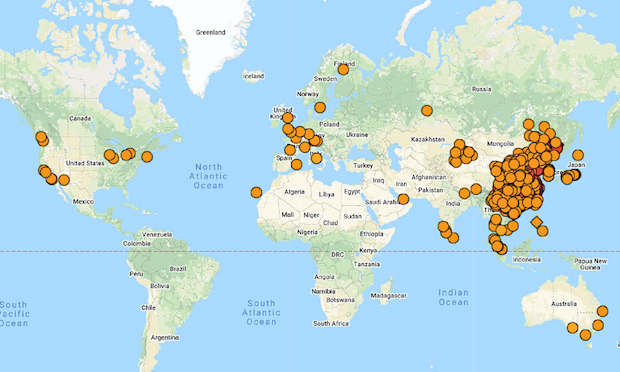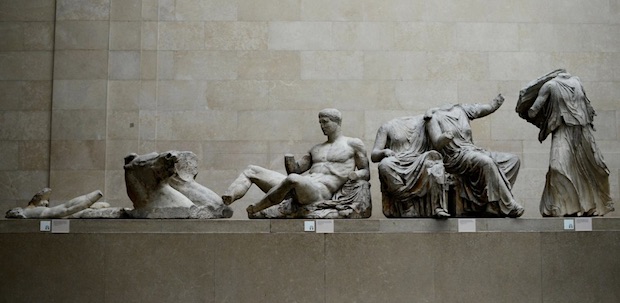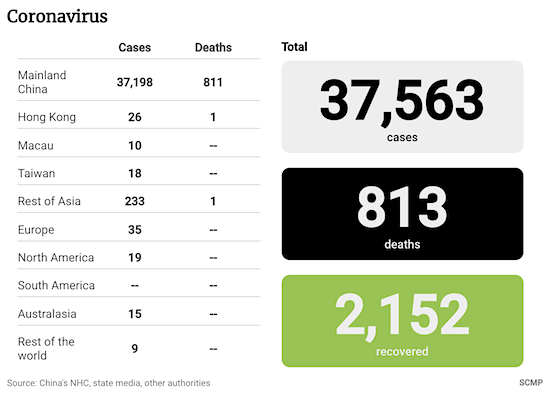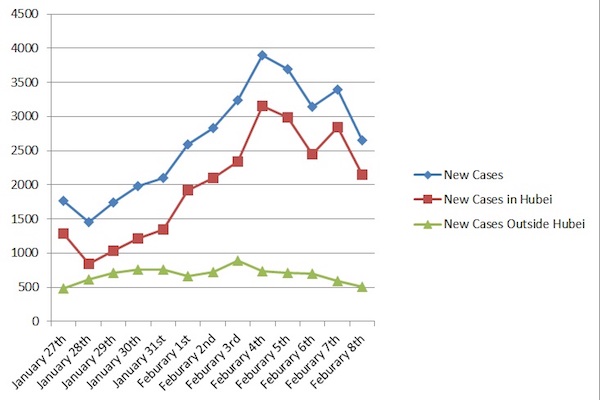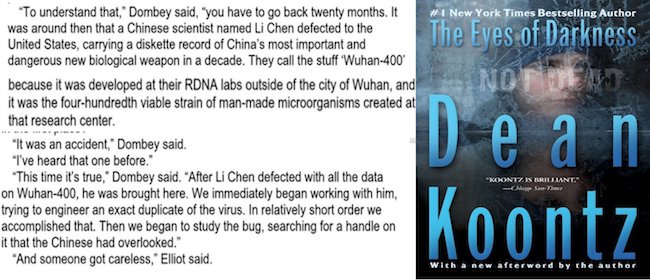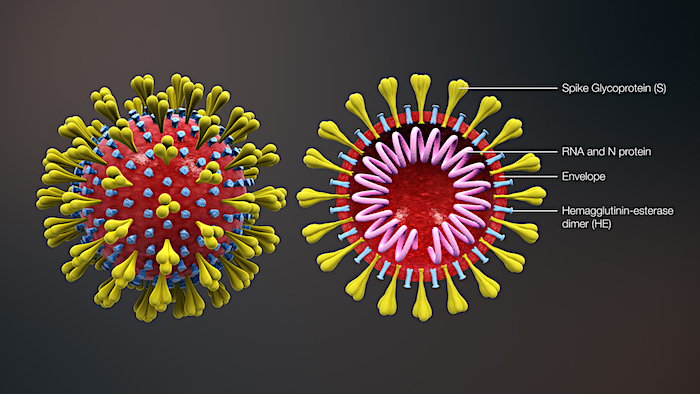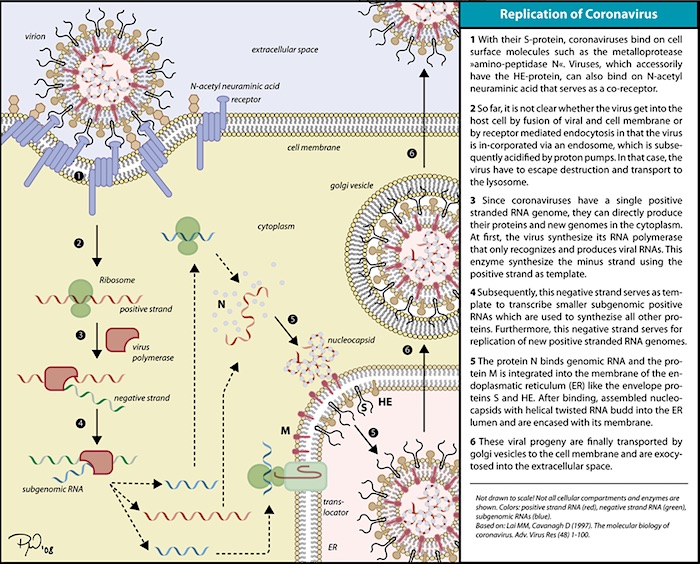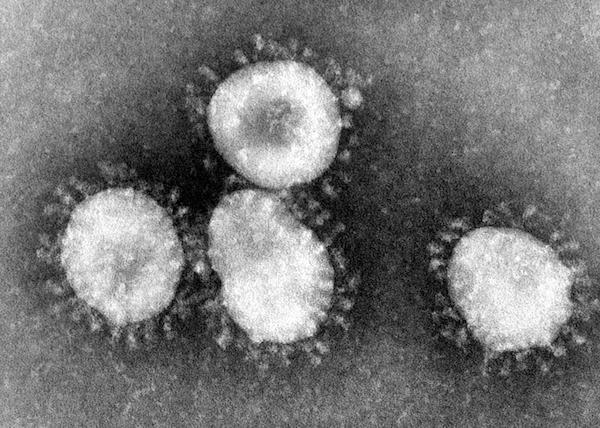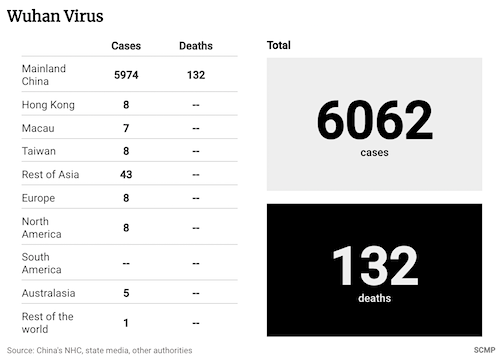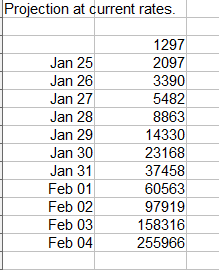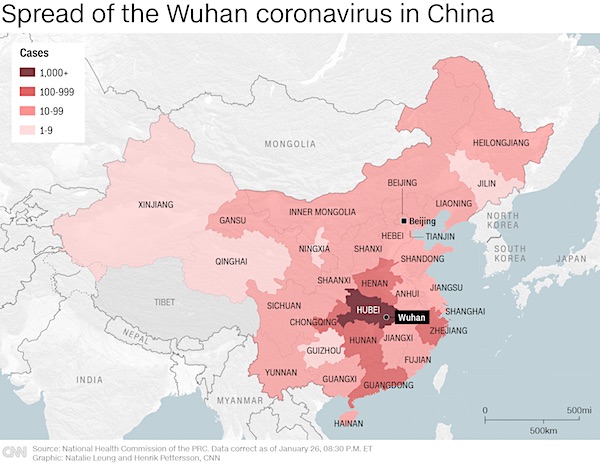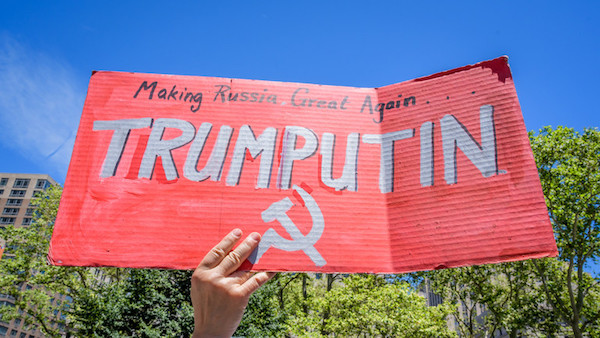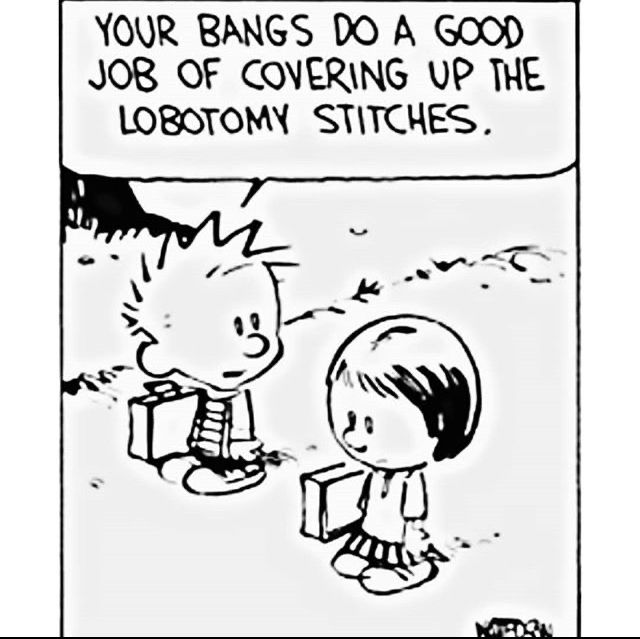
‘Daly’ Store, Manning, South Carolina 1941
• Cases 82,419 (+ 1,190 from yesterday’s 81,229).
• Deaths 2,808 (+ 39 from yesterday’s 2,769)
• Italy 468 cases (25% rise)
• South Korea 334 new cases, total 1,595 (26% rise)
• Japan 16 new cases, total 196, Diamond Princess 705
• US 60 cases
– 14 “US cases”, 3 repatriated from Wuhan and 42 from the Diamond Princess
– 83 monitored in Nassau County, Orange County declares state of emergency
– Health and Human Services Secretary Alex Azar: “We have 30 million surgical masks. Those would be the gauze tied behind the ear-type masks meant to really protect people from the healthcare workers spreading. We have 12 million N95 NIOSH-certified masks in the stockpile and we have about 5 million N95 masks that I believe may have expired, they’re no longer NIOSH-certified.”
• France 18 cases
• Pakistan confirms first 2 cases
• Norway, Greece first case
• Saudi Arabia bars pilgrims from Mecca
• South Korea has tested 40,000 people. Japan 900.
From SCMP:
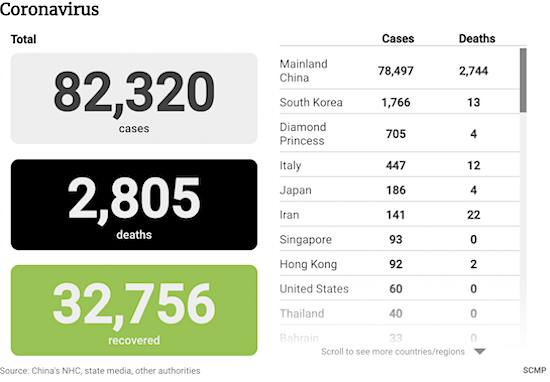
From Worldometer
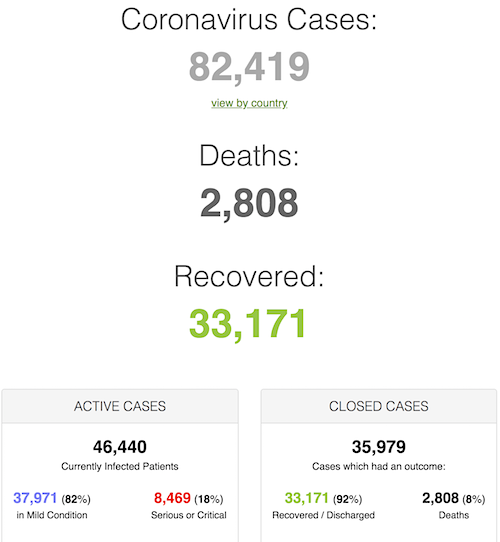

Coming soon to a town near you.
• China City Offers $1,400 To Virus Patients Who Report To Authorities (R.)
A city in China’s Hubei province, the epicenter of the global coronavirus epidemic, will pay residents as much as 10,000 yuan ($1,425.96) if they proactively report symptoms of the illness and it is confirmed after testing. Qianjiang, a city of around one million people located about 150 km (90 miles) from the stricken provincial capital of Wuhan, has reported a total of 197 cases so far and is stepping up efforts to ensure its infected people are confined and treated. It is the latest of a number of regions to offer cash rewards to encourage members of the public to volunteer for medical checks.
Hubei has reported over 65,000 cases and more than 2,600 deaths from the epidemic. Worldwide, the death toll is about 2,800 and about 80,000 have been infected. The Qianjiang task force handling the epidemic said in a notice that residents would be entitled to the full 10,000 yuan payment if their coronavirus diagnosis is confirmed. Those who have previously been diagnosed will not be eligible. Those who are not immediately ruled out as suffering from the disease will be given 1,000 yuan, while those declared to be “suspected” cases will earn 2,000 yuan, it said.

Also coming soon to a town near you.
• UK Hospitals To Deny Care To Weakest If Pandemic Hits (Ind.)
NHS patients could be denied lifesaving care during a severe coronavirus outbreak in Britain if intensive care units are struggling to cope, senior doctors have warned. Under a so-called “three wise men” protocol, three senior consultants in each hospital would be forced to make decisions on rationing care such as ventilators and beds, in the event hospitals were overwhelmed with patients. The medics spoke out amid frustration over what one said was the government’s “dishonest spin” that the health service was well prepared for a major pandemic outbreak. The doctors, from hospitals across England, said the health service’s existing critical care capacity was already overstretched and “would crumble” under the demands of a pandemic surge in patients who may all need ventilation to help them breathe.
Those denied intensive care beds could be those suffering with coronavirus or other seriously ill patients, with priority given to those most likely to survive and recover. Doctors said this would lead to “tough decisions” needing to be made about the wholesale cancellation of operations to free-up beds. One consultant said the “three wise men” protocol had been discussed at his hospital in recent weeks while another from the north of England said it had been raised “informally”. It was initially developed after the 2009 swine flu pandemic but is still included in several NHS trust plans seen by The Independent. One doctor explained: “If you can imagine the real worst-case scenarios where supply is massively outstripped by demand we would have to refuse to admit many people who would normally get ventilated.

Yeah, like when it turns out (s)he was infected in the Wuhan biolab.
• The Hunt For ‘Patient Zero’ – The World’s Health May Depend On It (SCMP)
Chinese officials are still trying to trace the epidemic back to its source in China. The first coronavirus case was reported to the WHO on December 31 and has been linked to Wuhan’s Huanan Wholesale Seafood Market. However, a new study published by a team of Chinese scientists last week said the virus might have been imported from somewhere else. The first known Covid-19 patient, a male who showed symptoms on December 8, had been discharged but said he was not at the Huanan market, the Wuhan government said in a Weibo post on Wednesday. “We don’t know who the very first patient zero was, presumably in Wuhan, and that leaves a lot of unanswered questions about how the outbreak started and how it initially spread,” Borwein said.
Knowing who patient zero is would help prevent future outbreaks and provide information about how to prevent transmission, Borwein said. But as time passes, identifying the index case grows increasingly difficult. “Figuring out who patient zero was wouldn’t give us all the answers but it would help to map the path the virus has taken and how it’s travelling,” she said. “It’s hard to draw that map without knowing where it starts.” John Nicholls, a University of Hong Kong clinical professor in pathology, said identifying patient zero during the severe acute respiratory syndrome (Sars) epidemic in 2002-03 was vital from an epidemiological perspective, as it highlighted the mode of its spread. The disease, which infected over 8,000 and killed 813 people globally, was traced to a then 64-year-old medical professor from Guangzhou, who had infected at least 13 tourists staying at the Metropole Hotel in Hong Kong.

Reinfection warrants much more attention than it gets.
• Japanese Woman Tests Positive For Second Time (R.)
A woman working as a tour bus guide in Japan has tested positive for coronavirus for a second time, in what authorities say is the first such case. The woman, in her 40s and a resident of Osaka in western Japan, tested positive on Wednesday after developing a sore throat and chest pains, the prefectural government said. She first tested positive on 29 January and was discharged from the hospital after recovering on 1 February, before testing negative on 6 February. The health ministry confirmed the case was the first in Japan where a patient tested positive for coronavirus for a second time after being discharged from hospital, Japanese media said. Though a first in Japan, cases of second positive tests have been reported in China. The outbreak has spread rapidly and widely, infecting about 80,000 people globally and killing nearly 2,800, the vast majority in mainland China.
“Once you have the infection, it could remain dormant and with minimal symptoms, and then you can get an exacerbation if it finds its way into the lungs,” said Professor Philip Tierno at New York University’s school of medicine. He said much remained unknown about the virus: “I’m not certain that this is not bi-phasic, like anthrax,” he said, meaning the disease might appear to go away before recurring. The woman’s second positive test came as the number of confirmed cases in Japan rose by 16 to 186, in addition to the 704 diagnosed from the Diamond Princess cruise ship. Tokyo has urged that big gatherings and sports events be scrapped or curtailed for two weeks to contain the virus, while pledging the 2020 Olympic Games will still go ahead.

We’re going to see large-scale HIV-drug testing on corona cases.
• HIV-Like Mutation Makes Coronavirus Far More Infectious Than Sars (SCMP)
The new coronavirus has an HIV-like mutation that means its ability to bind with human cells could be up to 1,000 times as strong as the Sars virus, according to new research by scientists in China and Europe. The discovery could help to explain not only how the infection has spread but also where it came from and how best to fight it. Scientists showed that Sars (severe acute respiratory syndrome) entered the human body by binding with a receptor protein called ACE2 on a cell membrane. And some early studies suggested that the new coronavirus, which shares about 80 per cent of the genetic structure of Sars, might follow a similar path.
But the ACE2 protein does not exist in large quantities in healthy people, and this partly helped to limit the scale of the Sars outbreak of 2002-03, iwhich infected about 8,000 people around the world. Other highly contagious viruses, including HIV and Ebola, target an enzyme called furin, which works as a protein activator in the human body. Many proteins are inactive or dormant when they are produced and have to be “cut” at specific points to activate their various functions. When looking at the genome sequence of the new coronavirus, Professor Ruan Jishou and his team at Nankai University in Tianjin found a section of mutated genes that did not exist in Sars, but were similar to those found in HIV and Ebola.
“This finding suggests that 2019-nCoV [the new coronavirus] may be significantly different from the Sars coronavirus in the infection pathway,” the scientists said in a paper published this month on Chinaxiv.org, a platform used by the Chinese Academy of Sciences to release scientific research papers before they have been peer-reviewed. “This virus may use the packing mechanisms of other viruses such as HIV.” According to the study, the mutation can generate a structure known as a cleavage site in the new coronavirus’ spike protein. The virus uses the outreaching spike protein to hook on to the host cell, but normally this protein is inactive. The cleavage site structure’s job is to trick the human furin protein, so it will cut and activate the spike protein and cause a “direct fusion” of the viral and cellular membranes.
Compared to the Sars’ way of entry, this binding method is “100 to 1,000 times” as efficient, according to the study. Just two weeks after its release, the paper is already the most viewed ever on Chinarxiv. [..] Chinese researchers said drugs targeting the furin enzyme could have the potential to hinder the virus’ replication in the human body. These include “a series of HIV-1 therapeutic drugs such as Indinavir, Tenofovir Alafenamide, Tenofovir Disoproxil and Dolutegravir and hepatitis C therapeutic drugs including Boceprevir and Telaprevir”, according to Li’s study.

Government ‘expert’ Zhong Nanshan does more whitewashing, praising the government response. Problem is, there WAS a huge delay. It should read: Virus Response Delay DID Add 100,000 Cases.
The same Zhong Nanshan said on Jan 28 that “..the number of new cases will plateau within the next ten days..”
• Virus Response Delay Could Have Added 100,000 Cases, China Expert (SCMP)
The number of daily coronavirus infections in South Korea could exceed those in China, with Beijing reporting 433 new cases on Thursday – slightly higher than the 406 of a day earlier – while South Korean cases surged on Thursday morning to 334, bringing its total infections to 1,595. If the number of new infections reported by Seoul continues to rise at the rate of recent days, South Korea’s cases could surpass China’s as early as Thursday afternoon, when health officials there are due to report their latest figures. China’s National Health Commission said 409 of its new cases were reported in Hubei province – the epicentre of the outbreak. [..] But cases outside Hubei returned to double digits, with 24 cases reported, a jump from just nine and five cases over the past two days respectively.
Zhong Nanshan, China’s top respiratory disease expert, said the number of patients would have been greatly reduced if China had taken action in early December, or even in early January. China announced human-to-human transmission of the virus on January 20, and Zhong said a delay of just a few more days could have led to well over 100,000 infections. “There have been three coronavirus outbreaks since the beginning of the 21st century. We should take actions to prevent it spreading whenever there is a coronavirus infection case. This is a big lesson for us,” Zhong said. He also called for more authority to be given to the Chinese Centre for Disease Control and Prevention (CDC) and its local branches.
Currently local CDCs only reports to their local governments who decide what action to take on communicable diseases. “In other countries, the CDC can report to the central government, and even alert the public directly under ‘special circumstances’. Although our expert team announced on January 20 that human to human transmissions had occurred, but that (the transmission) was discovered much earlier … nobody paid attention to it,” Zhong said. He said doctors, including Li Wenliang, had raised the alarm in mid to late December but it was not reported to the government until December 30, adding that the local government had not paid attention to the warnings, “or they did not understand what it was. That is why the spread has not been stopped”.

Why just the one?
• 60 Cases In US, One May Be Due To ‘Community Spread’ Of Infection (SCMP)
US health officials said on Wednesday they had detected a possible case of “community spread” of Covid-19 – the disease caused by the new coronavirus – with a patient testing positive, despite having no travel history to places with outbreaks or of being exposed to someone already infected. The US Centres for Disease Control and Prevention (CDC) statement was released soon after President Donald Trump said in a White House press briefing that he had appointed Vice-President Mike Pence to lead the containment effort against the spread of the illness that emerged in China’s Hubei province. Community transmission – in which multiple cases are detected without any clear source of infection – could significantly weaken the effectiveness of containment measures such as travel restrictions.
“At this time, the patient’s exposure is unknown. It’s possible this could be an instance of community spread of Covid-19, which would be the first time this has happened in the United States,” the CDC statement said. “It’s also possible, however, that the patient may have been exposed to a returned traveller who was infected,” it said. The patient tested positive for the illness after being screened by “astute clinicians” in the public health system in California, the CDC said. [..] The new case brings the total number of coronavirus infections in the US to 60. This includes 45 people who were either brought back from the central Chinese city of Wuhan – the epicentre of the outbreak – or from the Diamond Princess cruise ship in Japan

More government propaganda: “..normality could gradually return to the other 96 per cent of the economy.”
• At This Rate, How Is China’s Economy Going To Recover Lost Ground? (SCMP)
The escalation of the coronavirus epidemic has completely changed the consensus narrative about China’s economic performance in 2020. The cautious optimism that followed the signing of the phase one trade deal between the US and China has now given way to acute concerns about an economy that has been paralysed by a severe epidemic for more than a month. Even assuming a quick resolution to the crisis, followed by a decent recovery, the Chinese economy will probably struggle to deliver growth much higher than 5 per cent. Therefore, the consensus forecast for full-year growth of 5.8 per cent despite the epidemic – according to the latest Bloomberg survey – must reflect expectations of significant policy easing by China.
However, while stimulus measures may help the economy, it is worth cautioning that their effectiveness is heavily contingent on how the Covid-19 outbreak evolves. To the extent that much of China’s macro outlook will be driven by the epidemic, it is encouraging to see some progress in the fight against the coronavirus. Since early February, the daily increase in infection cases in China has fallen steadily, from nearly 4,000 to about 500. Recent changes in diagnostic methodology have created volatility in the data, but not derailed the overall declining trend. What is also encouraging is that the infection rate outside the epicentre of Hubei has dipped to below 10 cases a day, thanks to Beijing’s aggressive quarantine tactics to contain the spread of the coronavirus.
Since Hubei accounts for 4 per cent of China’s GDP, this means that normality could gradually return to the other 96 per cent of the economy. However, a rapid containment of the coronavirus is only a necessary, but by no means sufficient, condition for the realisation of the upbeat consensus forecast. Two other conditions are necessary: namely, an orderly resumption of the economy, and sufficient policy support. On the first point, there are fewer reasons for optimism. The draconian restrictions imposed by Beijing to contain the outbreak continue to hamper both the movement of people and the resumption of economic activity.

Middle East pressure cooker.
• Saudi Arabia Halts Travel To Islam’s Holiest Site To Prevent Spread (AP)
Saudi Arabia on Thursday halted travel to the holiest sites in Islam over fears about a new viral epidemic just months ahead of the annual haj pilgrimage, a move coming as the Middle East has over 220 confirmed cases of the illness. The extraordinary decision by Saudi Arabia stops foreigners from reaching the holy city of Mecca and the Kaaba, the cube-shaped structure the world’s 1.8 billion Muslims pray toward five times a day. It also said travel was suspended to Prophet Muhammad’s mosque in Medina. The decision showed the worry about the outbreak potentially spreading into Saudi Arabia, whose oil-rich monarchy stakes its legitimacy on protecting Islam’s holy sites.
The epicentre in the Middle East’s most-affected country, Iran, appears to be in the holy Shiite city of Qom, where a shrine there sees the faithful reach out to kiss and touch it in reverence. “Saudi Arabia renews its support for all international measures to limit the spread of this virus, and urges its citizens to exercise caution before travelling to countries experiencing coronavirus outbreaks,” the Saudi Foreign Ministry said in a statement announcing the decision. “We ask God Almighty to spare all humanity from all harm.” Disease outbreaks always have been a concern surrounding the haj, required of all able-bodied Muslims once in their life, especially as pilgrims come from all over the world. The earliest recorded outbreak came in 632 as pilgrims fought off malaria. A cholera outbreak in 1821 for instance killed an estimated 20,000 pilgrims. Another cholera outbreak in 1865 killed 15,000 pilgrims and then spread worldwide.

If a pandemic is declared after July 15, people stand to make a lot of dough.
• Pandemic Bonds: A “Scheme Like No Other” (Webb)
A little known specialized bond created in 2017 by the World Bank may hold the answer as to why U.S. and global health authorities have declined to label the global spread of the novel coronavirus a “pandemic.” Those bonds, now often referred to as “pandemic bonds,” were ostensibly intended to transfer the risk of potential pandemics in low-income nations to financial markets. Yet, in light of the growing coronavirus outbreak, the investors who purchased those products could lose millions if global health authorities were to use that label in relation to the surge in global coronavirus cases. On Tuesday, federal health officials at the Center for Disease Control and Prevention (CDC) announced that they are preparing for a “potential pandemic” of the novel coronavirus that first appeared in China late last year.
[..] some have argued that the CDC’s concerns about a likely pandemic have come too late and that action should have been taken much earlier. For instance, in early February, Dr. Anthony Fauci, director of the US National Institute of Allergy and Infectious Disease, had told the New York Times that the novel coronavirus is “very, very transmissible, and it almost certainly is going to be a pandemic,” while former CDC director Dr. Thomas R. Frieden had echoed those concerns at the time, stating that it is “increasingly unlikely that the virus can be contained.” Despite those warnings, among many others, the CDC waited to announce its concerns that the virus could spread throughout the United States. Their Tuesday announcement riled markets, wiping out $1.7 trillion in stock market value in just two days.
[..] In June 2017, the World Bank announced the creation of “specialized bonds” that would be used to fund the previously created Pandemic Emergency Financing Facility (PEF) in the event of an officially-recognized (i.e. WHO-recognized) pandemic. They were essentially sold under the premise that those who invested in the bonds would lose their money if any of six deadly pandemics hit, including coronavirus. Yet, if a pandemic did not occur before the bonds mature on July 15, 2020, investors would receive what they had originally paid for the bonds back in addition to interest and premium payments on those bonds that they recieve between the date of purchase and the bond’s maturation date.
The PEF, which these pandemic bonds fund, was created by the World Bank “to channel surge funding to developing countries facing the risk of a pandemic” and the creation of these so-called “pandemic bonds” was intended to transfer pandemic risk in low-income countries to global financial markets. According to a World Bank press release on the launch of the bonds, WHO backed the World Bank’s initiative. However, there is much more to these “pandemic bonds” than meets the eye. For example, PEF has a “unique financing structure [that] combines funding from the bonds issued today with over-the-counter derivatives that transfer pandemic outbreak risk to derivative counterparties.” The World Bank asserted that this structure was used in order “to attract a wider, more diverse set of investors.” Critics, however, have called the unnecessarily convoluted system “World-Bank-enabled looting” …

“..precedent of a High Court judge who called up Belmarsh prison’s governor on the phone to instruct him to change the prison’s practices towards an inmate..”
• Judge Refuses to Intervene In Mistreatment of Assange by Prison Officials (Sp.)
Julian Assange’s lawyers have repeatedly submitted unsuccessful requests to the Judge on his case, over the past few months, for her to intervene over his prison conditions, which have included denying Assange proper access to his case file. WikiLeaks founder Julian Assange has been subjected to “horrendous” treatment at the hands of prison authorities, the Belmarsh Magistrate’s Court (sitting at Woolwich Crown Court) heard on 25 February. The award-winning journalist and publisher was handcuffed 11 times as he was shuttled between the courthouse and the prison (despite the two locations being practically connected to each other), he was also strip-searched twice, and his legal papers were confiscated from him, according to his legal team and fellow WikiLeaks journalists.
Edward Fitzgerald QC, one of Assange’s barristers, pleaded with Judge Vanessa Baraitser to intervene with prison authorities. But she refused to intervene in any way, stressing that she had repeatedly told Assange’s lawyers that as far as she was concerned she had “no jurisdiction over [Assange’s] prison conditions”. Baraitser, who appeared frustrated with the request and points made by Fitzgerald, suggested that “surely this is a matter for the prison governor”. On 13 January 2020 Gareth Pierce, veteran human rights solicitor and part of Assange’s legal team, gave Baratiser precedent of a High Court judge who called up Belmarsh prison’s governor on the phone to instruct him to change the prison’s practices towards an inmate. But Baraitser was only prepared to go as far as to make a generalised statement in court that it would be “helpful” if the prison improved Assange’s access to his lawyers and his case file. Baraitser had also previously refused to intervene on 19 November 2019.

“Mr Assange, generally defendants do not have a voice.”
Truer words were never spoken about Julian.
• Assange Blasts Court For Preventing Communication With “Spied-On” Lawyers, (RT)
On the third day of his extradition hearing WikiLeaks founder Julian Assange has rebuked the court for preventing him from communicating with his legal team, saying his prosecutors have “100 times more contact hours each day.” Amid a prosecution argument about whether or not he stands charged with “political offenses” Assange stood and told the court that “the problem is I cannot participate, I cannot privately communicate with my lawyers.” Judge Vanessa Baraitser responded to the 48-year-old journalist and publisher by saying she would not allow him to address the court: “Mr Assange, generally defendants do not have a voice.”
The Australian continued to try and get his point across so the magistrate adjourned the court for five minutes while the defense team held a ‘private’ meeting. “The other side must have something like 100 contact hours each day,” Assange said upon the conclusion of the adjournment, before adding that his legal team is being spied on. There is already enough spying on my lawyers as it is. There are a number of unnamed embassy officials here. There are two microphones in here. What’s the point of asking if I can concentrate if I can’t participate? “I am as much a participant in these proceedings as I am at Wimbledon,” Assange wistfully joked while alleging that there was a microphone in the glass defendants dock.
The defense team asked for Assange to be removed from the dock so that he could sit with them; prosecutors reportedly didn’t object but the judge felt the security team might. “It is your call Madam,” the prosecutors said. Defense counsel Edward Fitzgerald argued that Assange is “no threat to anyone,” adding: “He is a gentle man of an intellectual nature. There’s no reason for him not to sit with us.” The judge then asked whether they would like to submit a formal bail application to make that a reality. The defense team will now submit such a formal bail application and a decision will be made on Thursday morning. For the time being, Assange will remain in the dock away from his legal team.
This courageous voice is currently confined at the back of a shameful court in #UK behind a bulletproof glass screen as if he was a war criminal, while the real war criminals are free. But they will be accused – and this is what they fear most. Listen to #Assange! pic.twitter.com/NStFaxzWk0
— Srećko Horvat (@HorvatSrecko) February 26, 2020

“..the existence of a treaty is the fundamental basis of the Assange extradition request and that, without a treaty, there would be no such request in the first place. Choosing to ignore the provisions of such a treaty is itself an abuse of process..”
• Assange Detention Illegal Under English, European And International Law (RT)
Day three of the Julian Assange extradition hearing is focusing on whether the allegations against Assange amount to “political offenses.” If so, it would likely be outside of the judge’s jurisdiction to approve extradition. Kicking off proceedings at Woolwich Crown Court on Wednesday, defense counsel Edward Fitzgerald argued that 17 of the 18 counts with which the WikiLeaks founder has been charged fall under the US Espionage Act, which makes them political on face value. He added that the 18th count, of conspiracy to commit computer intrusion, was in order to carry out the other alleged offenses. Discussing the policy of not extraditing for political offenses, Assange’s lawyer said: “It is an essential fundamental protection, which the US puts in every single one of its extradition treaties.”
Fitzgerald said that political defence from extradition goes back 100 years and is standard in treaties based on the UN model, including the European Union convention on extradition, the Interpol convention and many others. “The more we research this, the more one sees this is a universal norm.” He also noted that while the US adds the ‘political defense’ extradition provision into all of its treaties, authorities there only take issue when it is invoked against them, despite using it to protect US citizens from extradition to hostile nations. WikiLeaks editor Kristinn Hrafnsson provided a video update from outside the court, saying that the case should be thrown out. “This is in contravention to all international treaties, to European Convention on Human Rights to UN treaties,” he said.
Fitzgerald cited numerous precedents tying international law and the ECHR with English law in determining the legality of detention, essentially arguing that Assange’s detention is illegal under all three. Furthermore, the initial charge of conspiracy to commit computer intrusion is illegal under US law, not English law, rendering all subsequent arguments inadmissible. He continued that the right to due process has been a part of English law since the Magna Carta, while also forming a cornerstone of the constitution. Fitzgerald then added that the existence of a treaty is the fundamental basis of the Assange extradition request and that, without a treaty, there would be no such request in the first place. Choosing to ignore the provisions of such a treaty is itself an abuse of process, he added.
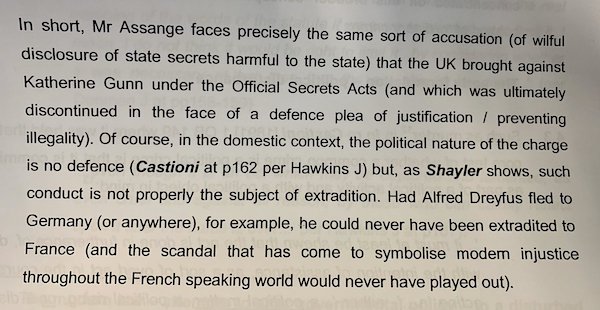

Illegal under American law too.
• Prosecution of Julian Assange Violates First Amendment (Napolitano)
“Congress shall make no law… abridging the freedom of speech.” — First Amendment to the U.S. Constitution In the oral argument of the famous U.S. Supreme Court cases known collectively as the Pentagon Papers Case, the late Justice William O. Douglas asked a government lawyer if the Department of Justice views the “no law” language in the First Amendment to mean literally no law. The setting was an appeal of the Nixon administration’s temporarily successful efforts to bar The New York Times and The Washington Post from publishing documents stolen from the Department of Defense by Daniel Ellsberg. The documents were a history of the Vietnam War, which revealed that President Lyndon B. Johnson and his secretaries of defense and state and the military’s top brass materially misrepresented the status of the war to the American people.
Stated differently, they regularly, consistently and systematically lied to the public and the news media. Though LBJ was retired, Nixon did not want this unvarnished version of the war he was still fighting to make its way into the public arena. The Nixon DOJ persuaded a federal district court judge to enjoin the publication of the documents because they contained classified materials and they had been stolen. In a landmark decision, the court ruled that all truthful matters material to the public interest that come into the hands of journalists – no matter how they get there – may lawfully be disseminated. That does not absolve the thief – though the case against Ellsberg was dismissed because the FBI committed crimes against him during his prosecution – but it does insulate the publisher absolutely against civil and criminal liability.

Trump can launch a hundred of these lawsuits against the NYT alone. This is from Reuters, published in the Guardian. All MSM, and all clinging to the “Mueller established so-and-so” narrative. Mueller didn’t establish a thing, other than an all-pervasive bias. All he had left after 3 years was 13 Russians and Assange who could’t speak up for themselves. And there’s still people who say Mueller is not a liar and a coward.
• Trump Campaign Sues New York Times For Libel Over Russia Story (R.)
Donald Trump’s re-election campaign said on Wednesday it had filed a libel suit against the New York Times accusing the newspaper of intentionally publishing a false opinion article related to Russian interference in the 2016 US election. In an escalation of the Republican president’s long-running battle with the news media, campaign officials said the lawsuit was being filed in New York state supreme court, the state’s trial-level court. A statement from the campaign said the aim of the litigation was to “hold the news organization accountable for intentionally publishing false statements against President Trump’s campaign”. The lawsuit relates to a 27 March 2019, opinion article written by Max Frankel, who served as executive editor of the Times from 1986 to 1994.
The campaign attached to a news release a draft copy of the suit accusing the newspaper of “extreme bias against (the campaign) and animosity” and cited what it called the Times’ “exuberance to improperly influence the presidential election in November 2020”. Trump is seeking re-election on 3 November. The opinion piece was headlined, “The Real Trump-Russia Quid Pro Quo” with a subhead adding, “The campaign and the Kremlin had an overarching deal: help beat Hillary Clinton for a new pro-Russian foreign policy.” Quid pro quo is a Latin term meaning a favor in exchange for a favor. The lawsuit originated with the Trump re-election campaign, but Trump himself has contended the Times has at times been biased against him.
Former special counsel Robert Mueller documented Moscow’s campaign of hacking and social media propaganda to boost Trump’s 2016 candidacy and harm his Democratic opponent, Hillary Clinton. It documented numerous contacts between people associated with Trump’s campaign and Russians. Mueller found insufficient evidence to show a criminal conspiracy between Trump’s team and Russia but did not exonerate Trump of obstruction of justice related to the investigation. In the opinion piece, Frankel stated, “Collusion – or a lack of it – turns out to have been the rhetorical trap that ensnared President Trump’s pursuers.”
Frankel added: “There was no need for detailed electoral collusion between the Trump campaign and Vladimir Putin’s oligarchy because they had an overarching deal: the quid of help in the campaign against Hillary Clinton for the quo of a new pro-Russian foreign policy, starting with relief from the Obama administration’s burdensome economic sanctions. The Trumpites knew about the quid and held out the prospect of the quo.”
Jenna Ellis, senior legal adviser to Donald J Trump for President Inc, said: “Today the President’s re-election campaign filed suit against the New York Times for falsely stating the Campaign had an ‘overarching deal’ with ‘Vladimir Putin’s oligarchy’ to ‘help the campaign against Hillary Clinton’ in exchange for ‘a new pro-Russian foreign policy, starting with relief from … economic sanctions’. “The statements were and are 100% false and defamatory. The complaint alleges the Times was aware of the falsity at the time it published them, but did so for the intentional purpose of hurting the campaign, while misleading its own readers in the process,” Ellis said. In a copy of the lawsuit provided by his re-election team, the campaign stated, “The Times was well aware when it published these statements that they were not true.”

When you see scary things in the news, there’s always the Automatic Earth. Your helper.
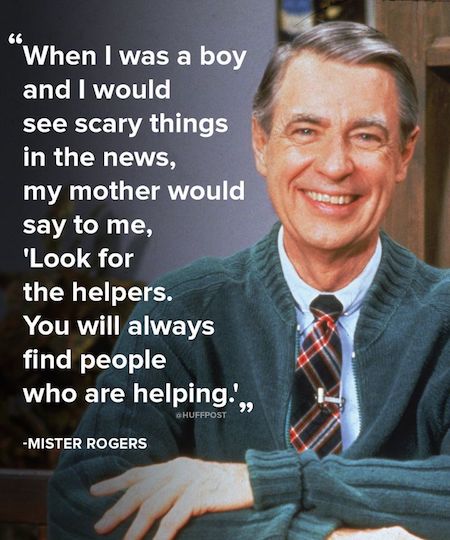

If you read us, please support us. It’s the only way the Automatic Earth can survive. Donate on Paypal and Patreon.


